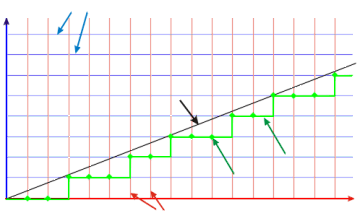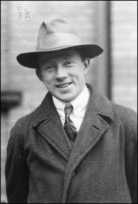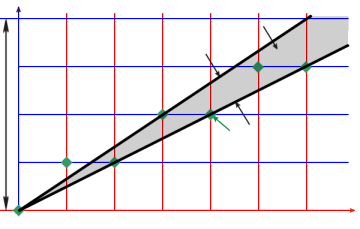Théorie de l'univers échantillonné
3. Le principe d'incertitude
de Heisenberg
That is the third analogy : in both Quantum
Mechanics and Digital Signal Processing, that is impossible to know accurately
both the position and the speed of a particle. When you know the position there
is an uncertainty on the speed, and when you know the speed there is an
uncertainty on the position.
That is not easy to understand it in Quantum Mechanics, as
that is necessary to use advanced mathematics, but that is quite easy to
understand it in Digital Signal Processing by using simple diagrams.
Traitement numérique du signal
Version 1
February 8, 2007
Samples, at the intersections
of spatial and temporal grids
The Uncertainty Principle was discovered by Heisenberg in
1927.
It had important implications, as that was the end of
determinism in science and in philosophy.
The philosophy of determinism was derived from science, from
Newton's laws, and pre-Newtonian physics, in that the ability to predict future
outcomes in the universe (such as future position of planets) was made possible
by science.
In digital signal processing, when sampling the
trajectory of a particle, we get a sampled trajectory which looks like a
staircase, as the samples have to be placed on the spatial and temporal
grids:
Real trajectory
of a
real particle
Area of
uncertainty
In the sampled universe, we have only samples (the green
dots). Thus there is an approximation on the position of the real particle. The
shaded area represents the area of uncertainty:
According to quantum mechanics, you couldn't measure
both the position and the speed of a particle exactly.
Quantum mechanics took away predictability and therefore was a blow to
philosophy.
According to science, that is necessary to know exactly both
the speed and the position of every particle in order to predict the future.
According to the Uncertainty Principle that is impossible, thus we cannot
predict perfectly the behavior of particles and planets.
That is necessary to use advanced mathematics to demonstrate
the Uncertainty Principle, and Quantum mechanics does not allow intuitive
representations of its principles.
But by looking at the analogy with Digital Signal Processing
presented on the right side, we can see easily how a quantification process is
creating that kind of uncertainties in space and time.
The purpose of that analogy is to consider the possibility of
an infinite universe behind our physical universe, which might be the
spiritual universe.
Heisenberg himself had a similar intuition in his original
paper in 1927: he was discussing the idea that there might exist a hidden
reality behind the physical universe, but he said that the aim of
physics is only to describe observable data, so he was not interested in digging
further.
I have a different opinion: I consider that the aim of
physics should be to unveil the ultimate reality of things, and there is no
reason to believe that it is impossible without even trying.
So I am looking for ways to study that hidden reality.
That is not only a matter of pure knowledge, but
also a matter of survival, as that kind of knowledge might unveil some of
the deeper mysteries about life and death.
Area of uncertainty
in position
Measuring the speed
If we want to predict the future trajectory of the particle, we have to
know both its position and its speed. In order to know the speed, we have to
measure the change in position versus time.
In the following example, we are measuring the speed of the particle for
a change of position of 2Lu (units of length.)The uncertainty in
position is 2Lu, as in order to know the speed we have to assume that
the trajectory is linear, when it is not necessarily so:
Area of uncertainty
in speed
Trajectory for the
maximum possible
speed
Trajectory for the
minimum possible
speed
Uncertainty
in position
= 2 Lu
A better precision in speed, but
a lower precision in position
In the following example, we measure the speed over 4 units of position, in
order to have a better precision in speed. But we have a lower
precision in position:
Area of uncertainty
in speed
Trajectory for the
maximum possible
speed
Trajectory for the
minimum possible
speed
Uncertainty
in position
= 4 Lu
Formulas
The following formulas are the classical formulas of Quantum Mechanics.
The formula of the uncertainty principle is:
Where
is the uncertainty in position
is the uncertainty in momentum
is the reduced Planck's constant
Now the momentum p is given by the formula
where
= momentum
= mass
= velocity
Hence
Therefore, when measuring the velocity with a higher
accuracy, the accuracy in position deteriorates.
Formulas
The following table shows the numerical values measured on the graphs
above and the ensuing computations:
Comparing the formulas
Eventually we see that in both Quantum Mechanics and Digital Signal
Processing, we have
That is the formula of the best possible accuracy. But we can of course
decide to have a worse accuracy, hence the formula becomes:
The analogy is not perfect, as for Digital Signal Processing we are using a
one dimensional space when in Quantum Mechanics space is tri dimensional,
and we did not introduce the notion of mass in Digital Signal Processing.
But the analogy points clearly to the fact that
with the Sampling Universe Theory we have a relation of uncertainty similar to
the Heisenberg Uncertainty Principle.











